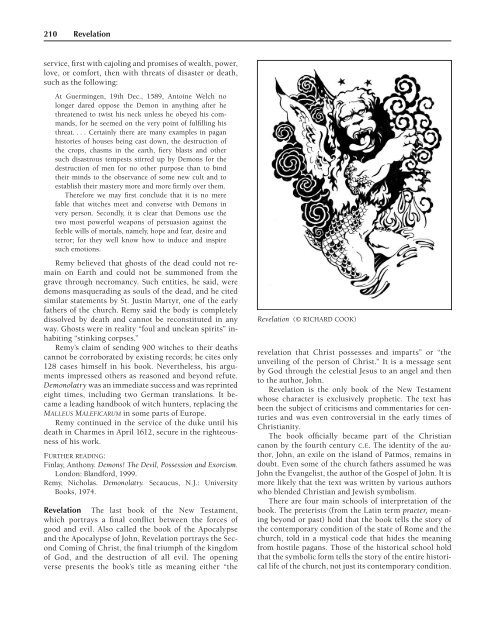The Encyclopedia Of Demons And Demonology
The Encyclopedia Of Demons And Demonology
The Encyclopedia Of Demons And Demonology
You also want an ePaper? Increase the reach of your titles
YUMPU automatically turns print PDFs into web optimized ePapers that Google loves.
210 Revelation<br />
service, first with cajoling and promises of wealth, power,<br />
love, or comfort, then with threats of disaster or death,<br />
such as the following:<br />
At Guermingen, 19th Dec., 1589, Antoine Welch no<br />
longer dared oppose the Demon in anything after he<br />
threatened to twist his neck unless he obeyed his commands,<br />
for he seemed on the very point of fulfilling his<br />
threat. . . . Certainly there are many examples in pagan<br />
histories of houses being cast down, the destruction of<br />
the crops, chasms in the earth, fiery blasts and other<br />
such disastrous tempests stirred up by <strong>Demons</strong> for the<br />
destruction of men for no other purpose than to bind<br />
their minds to the observance of some new cult and to<br />
establish their mastery more and more firmly over them.<br />
<strong>The</strong>refore we may first conclude that it is no mere<br />
fable that witches meet and converse with <strong>Demons</strong> in<br />
very person. Secondly, it is clear that <strong>Demons</strong> use the<br />
two most powerful weapons of persuasion against the<br />
feeble wills of mortals, namely, hope and fear, desire and<br />
terror; for they well know how to induce and inspire<br />
such emotions.<br />
Remy believed that ghosts of the dead could not remain<br />
on Earth and could not be summoned from the<br />
grave through necromancy. Such entities, he said, were<br />
demons masquerading as souls of the dead, and he cited<br />
similar statements by St. Justin Martyr, one of the early<br />
fathers of the church. Remy said the body is completely<br />
dissolved by death and cannot be reconstituted in any<br />
way. Ghosts were in reality “foul and unclean spirits” inhabiting<br />
“stinking corpses.”<br />
Remy’s claim of sending 900 witches to their deaths<br />
cannot be corroborated by existing records; he cites only<br />
128 cases himself in his book. Nevertheless, his arguments<br />
impressed others as reasoned and beyond refute.<br />
Demonolatry was an immediate success and was reprinted<br />
eight times, including two German translations. It became<br />
a leading handbook of witch hunters, replacing the<br />
MALLEUS MALEFICARUM in some parts of Europe.<br />
Remy continued in the service of the duke until his<br />
death in Charmes in April 1612, secure in the righteousness<br />
of his work.<br />
FURTHER READING:<br />
Finlay, Anthony. <strong>Demons</strong>! <strong>The</strong> Devil, Possession and Exorcism.<br />
London: Blandford, 1999.<br />
Remy, Nicholas. Demonolatry. Secaucus, N.J.: University<br />
Books, 1974.<br />
Revelation <strong>The</strong> last book of the New Testament,<br />
which portrays a final conflict between the forces of<br />
good and evil. Also called the book of the Apocalypse<br />
and the Apocalypse of John, Revelation portrays the Second<br />
Coming of Christ, the final triumph of the kingdom<br />
of God, and the destruction of all evil. <strong>The</strong> opening<br />
verse presents the book’s title as meaning either “the<br />
Revelation (© RICHARD COOK)<br />
revelation that Christ possesses and imparts” or “the<br />
unveiling of the person of Christ.” It is a message sent<br />
by God through the celestial Jesus to an angel and then<br />
to the author, John.<br />
Revelation is the only book of the New Testament<br />
whose character is exclusively prophetic. <strong>The</strong> text has<br />
been the subject of criticisms and commentaries for centuries<br />
and was even controversial in the early times of<br />
Christianity.<br />
<strong>The</strong> book officially became part of the Christian<br />
canon by the fourth century C.E. <strong>The</strong> identity of the author,<br />
John, an exile on the island of Patmos, remains in<br />
doubt. Even some of the church fathers assumed he was<br />
John the Evangelist, the author of the Gospel of John. It is<br />
more likely that the text was written by various authors<br />
who blended Christian and Jewish symbolism.<br />
<strong>The</strong>re are four main schools of interpretation of the<br />
book. <strong>The</strong> preterists (from the Latin term praeter, meaning<br />
beyond or past) hold that the book tells the story of<br />
the contemporary condition of the state of Rome and the<br />
church, told in a mystical code that hides the meaning<br />
from hostile pagans. Those of the historical school hold<br />
that the symbolic form tells the story of the entire historical<br />
life of the church, not just its contemporary condition.












